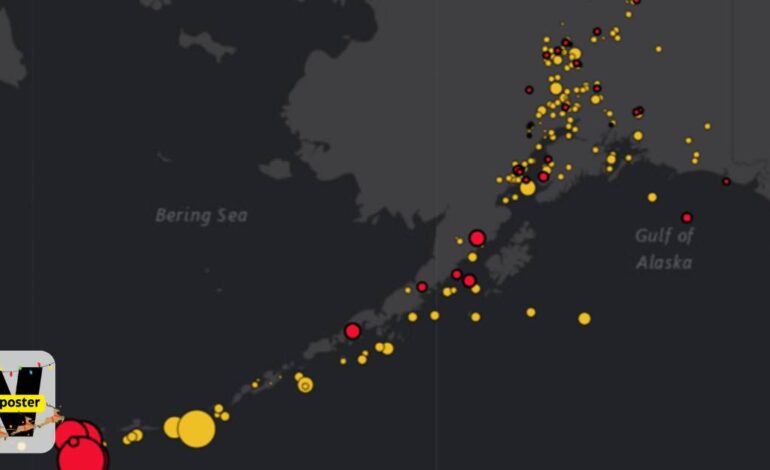
Ongoing Earthquake Swarm in Alaska’s Aleutian Islands: Seismologists Monitor Multiple Strong Quakes as Tremors Persist in Region, No Immediate Threat of Tsunami
Ongoing Earthquake Swarm in Alaska’s Aleutian Islands: Seismologists Monitor Multiple Strong Quakes as Tremors Persist in Region, No Immediate Threat of Tsunami
Introduction
In a region already known for its seismic activity, the Aleutian Islands off the coast of Alaska are experiencing a swarm of earthquakes that have shaken the area in recent days. On Sunday morning, the first of a series of powerful tremors struck, registering a magnitude 6.3 earthquake in the Pacific Ocean, approximately 70 miles southwest of Adak, Alaska. The initial quake was followed by numerous aftershocks, some nearly as strong as the original event. The U.S. Geological Survey (USGS) and seismologists have been closely monitoring the swarm, which appears to be part of an ongoing series of significant seismic events.
What Is an Earthquake Swarm?
An earthquake swarm is a series of seismic events that occur in a specific region over a relatively short period of time, often without a clear mainshock. Unlike traditional aftershock sequences, where a large event is followed by progressively smaller tremors, swarms can involve multiple strong quakes occurring nearly simultaneously, or within minutes or hours of each other. The Aleutian Islands, a highly active seismic zone, are no stranger to such swarms, but the scale and frequency of the current swarm has raised concerns about possible aftereffects, even if no immediate tsunami warnings have been issued.
The Aleutian Islands lie on the boundary between the Pacific and North American tectonic plates, a boundary known as the Pacific Ring of Fire, where earthquakes and volcanic activity are frequent due to the movement of these massive plates.
Sequence of Events
On Sunday, the first tremor in the swarm struck at approximately 11:00 a.m. local time. The quake had a magnitude of 6.3 and occurred in the Pacific Ocean off the southwest coast of Adak, Alaska. This was followed by at least six aftershocks within the next hour, ranging from magnitudes of 4.0 to 5.8. These aftershocks were notable not only for their strength but also for their close proximity in time, which set the stage for what became a swarm of earthquakes.
In a surprising turn of events, two additional quakes, each measuring greater than magnitude 6.0, struck within 20 minutes of each other later in the day. The magnitude of these quakes placed them firmly within the category of significant seismic activity, raising concerns about their potential impact on the region, both in terms of infrastructure and public safety.
Seismologist Response and Regional Monitoring
Seismologists, including those from the University of Alaska Fairbanks, have been closely monitoring the situation. Michael West, Director of the Alaska Earthquake Center, noted that while earthquake swarms in the Aleutian Islands are not uncommon, the intensity of the quakes in this sequence sets it apart. However, West emphasized that such swarms do not necessarily indicate that a larger, more catastrophic event is imminent. Earthquakes of this magnitude are expected in the region given its geological history, and while the current series of quakes is certainly significant, it is not out of the ordinary for this highly active seismic zone.
The ongoing activity is being tracked by both state and federal authorities. The Alaska Earthquake Center, along with the USGS, is issuing frequent updates on the status of the swarm. As of now, the region is expected to experience more aftershocks, possibly with magnitudes of 5.0 or lower, over the coming weeks.
Despite the significant tremors, the National Oceanic and Atmospheric Administration (NOAA) has not issued any tsunami warnings for the Aleutian Islands, highlighting the region’s seismic resilience. Tsunami warnings are typically issued when an earthquake occurs at sea, but these are contingent on factors such as the depth of the earthquake and its potential to displace large amounts of water.
The Risk of Further Seismic Activity
While the possibility of additional quakes remains high, experts emphasize that the risk of a devastating event—such as a large-scale tsunami—remains low for now. The seismic activity being observed is typical of earthquake swarms that can occur without evolving into larger events. Seismologists point to the region’s history, noting that while the Aleutians are prone to major earthquakes, they do not always result in catastrophic consequences.
In particular, the Aleutian Islands have a history of producing major earthquakes. The region has experienced numerous quakes with magnitudes of 7.0 or higher, as well as several large tsunamis, though the current swarm does not appear to pose an immediate tsunami threat.
Impact on Local Communities and Infrastructure
Although the initial tremors of the current earthquake swarm have not led to significant structural damage, local communities in the Aleutian Islands remain on high alert. The population in this remote area is sparse, but the potential impact on local infrastructure and the economy is concerning. Adak, which is one of the closest communities to the epicenter of the quakes, has a population of less than 200 people. Still, the people living in this area are accustomed to seismic activity, though the intensity of the current swarm has led many residents to prepare for potential aftershocks.
Public safety efforts in the region have been focused on ensuring that local emergency services are prepared for any consequences. Alaska’s Department of Emergency Management has been working closely with local authorities, ensuring that residents in the affected areas are informed and ready to respond to any seismic developments.
In addition, Alaskan officials have been coordinating with the Federal Emergency Management Agency (FEMA) to assess any damage that may result from future aftershocks, particularly in the case of infrastructure damage or the disruption of essential services.
Looking Ahead: Continued Monitoring and Public Communication
While no major injuries have been reported so far, experts are continuing to monitor the area for signs of more significant seismic events. The USGS and Alaska Earthquake Center are maintaining an increased presence in the region, conducting daily assessments of the situation. The public is being kept updated through continuous reports and alerts, ensuring that residents are aware of any significant changes in seismic activity.
Seismologists continue to emphasize the unpredictability of earthquake swarms. Although the region is accustomed to seismic activity, the frequency and intensity of these quakes remain cause for caution. Residents and local authorities have been urged to remain vigilant, continue to monitor alerts, and take necessary precautions.
Conclusion
The ongoing earthquake swarm off Alaska’s Aleutian Islands serves as a reminder of the region’s seismic volatility. While the series of quakes has been significant, the likelihood of a catastrophic event remains low. Seismologists continue to study the ongoing activity, ensuring that any further developments are carefully tracked. Local communities are preparing for the possibility of more aftershocks, while public safety efforts continue to safeguard residents in the affected areas.
For now, the situation remains under close scrutiny, and the Aleutians continue to showcase their seismic resilience. Although the tremors of this earthquake swarm are undoubtedly unsettling, they are not unusual for a region that has long been familiar with the forces of nature.



